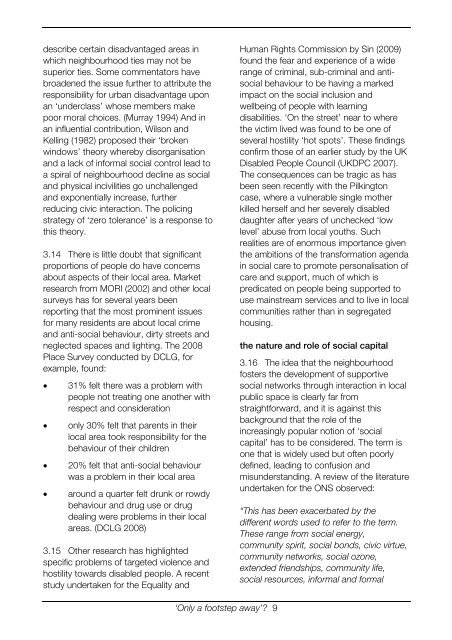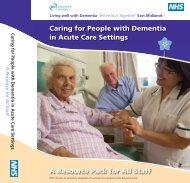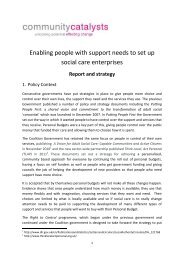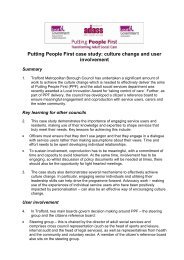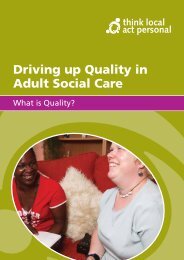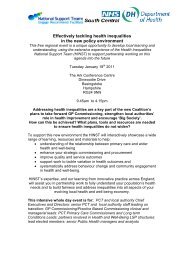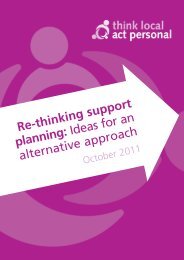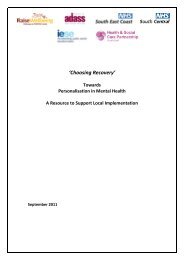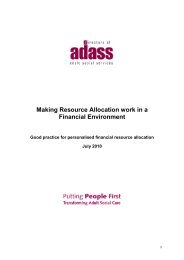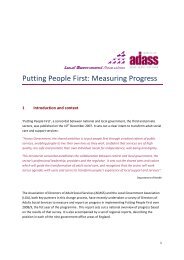'Only a footstep away' - Skills for Care - Think Local Act Personal
'Only a footstep away' - Skills for Care - Think Local Act Personal
'Only a footstep away' - Skills for Care - Think Local Act Personal
- No tags were found...
You also want an ePaper? Increase the reach of your titles
YUMPU automatically turns print PDFs into web optimized ePapers that Google loves.
describe certain disadvantaged areas inwhich neighbourhood ties may not besuperior ties. Some commentators havebroadened the issue further to attribute theresponsibility <strong>for</strong> urban disadvantage uponan ‘underclass’ whose members makepoor moral choices. (Murray 1994) And inan influential contribution, Wilson andKelling (1982) proposed their ‘brokenwindows’ theory whereby disorganisationand a lack of in<strong>for</strong>mal social control lead toa spiral of neighbourhood decline as socialand physical incivilities go unchallengedand exponentially increase, furtherreducing civic interaction. The policingstrategy of ‘zero tolerance’ is a response tothis theory.3.14 There is little doubt that significantproportions of people do have concernsabout aspects of their local area. Marketresearch from MORI (2002) and other localsurveys has <strong>for</strong> several years beenreporting that the most prominent issues<strong>for</strong> many residents are about local crimeand anti-social behaviour, dirty streets andneglected spaces and lighting. The 2008Place Survey conducted by DCLG, <strong>for</strong>example, found:• 31% felt there was a problem withpeople not treating one another withrespect and consideration• only 30% felt that parents in theirlocal area took responsibility <strong>for</strong> thebehaviour of their children• 20% felt that anti-social behaviourwas a problem in their local area• around a quarter felt drunk or rowdybehaviour and drug use or drugdealing were problems in their localareas. (DCLG 2008)3.15 Other research has highlightedspecific problems of targeted violence andhostility towards disabled people. A recentstudy undertaken <strong>for</strong> the Equality andHuman Rights Commission by Sin (2009)found the fear and experience of a widerange of criminal, sub-criminal and antisocialbehaviour to be having a markedimpact on the social inclusion andwellbeing of people with learningdisabilities. ‘On the street’ near to wherethe victim lived was found to be one ofseveral hostility ‘hot spots’. These findingsconfirm those of an earlier study by the UKDisabled People Council (UKDPC 2007).The consequences can be tragic as hasbeen seen recently with the Pilkingtoncase, where a vulnerable single motherkilled herself and her severely disableddaughter after years of unchecked ‘lowlevel’ abuse from local youths. Suchrealities are of enormous importance giventhe ambitions of the trans<strong>for</strong>mation agendain social care to promote personalisation ofcare and support, much of which ispredicated on people being supported touse mainstream services and to live in localcommunities rather than in segregatedhousing.the nature and role of social capital3.16 The idea that the neighbourhoodfosters the development of supportivesocial networks through interaction in localpublic space is clearly far fromstraight<strong>for</strong>ward, and it is against thisbackground that the role of theincreasingly popular notion of ‘socialcapital’ has to be considered. The term isone that is widely used but often poorlydefined, leading to confusion andmisunderstanding. A review of the literatureundertaken <strong>for</strong> the ONS observed:“This has been exacerbated by thedifferent words used to refer to the term.These range from social energy,community spirit, social bonds, civic virtue,community networks, social ozone,extended friendships, community life,social resources, in<strong>for</strong>mal and <strong>for</strong>mal‘Only a <strong>footstep</strong> away’? 9


